This Is The Visible Spectrum Of The Light From The Sun. And If You Have Played With White Light And Prisms
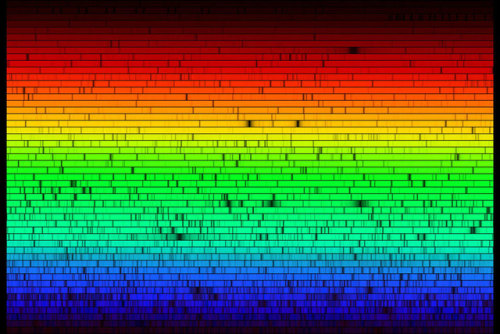
This is the visible spectrum of the light from the sun. And if you have played with white light and prisms before, it might come as a huge surprise to you to know that the spectrum from the sun is actually not continuous.

Why is it not ? The dark patches in the above spectrum arise from gas at or above the Sun’s surface absorbing sunlight emitted below.

Source
Since there are different types of gases that compose the sun, there are numerous wavelengths of light that get absorbed by these gases.

Source: xkcd
How do we know which line corresponds to which ? Well, it’s because we have a periodic table, and we know the spectrum of all the elements in it:

Source
And then it’s a matter of solving the jigsaw puzzle of fitting the spectrum with the tiles that you have. When we do so, we obtain the following composition of elements:

Source: Earth Blog
We can even take it one step further by finding the composition of other neighboring stars as well.

Source: Potsdam University
All of this information about the star can be captured from a simple spectrum. And this is why one of the most important tool that an astronomer has about an object is it’s spectrum.
Have a good one!
Edit: Added all sources for the images.
More Posts from Riekod and Others

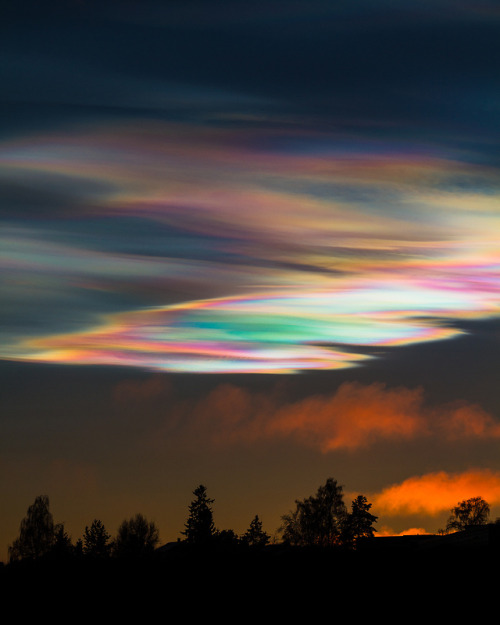
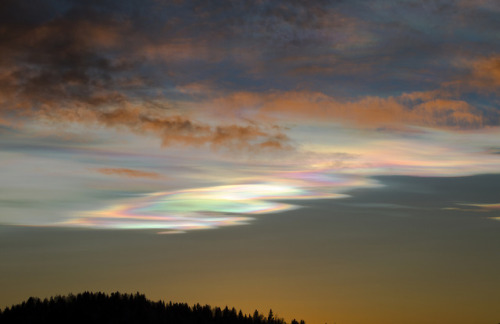

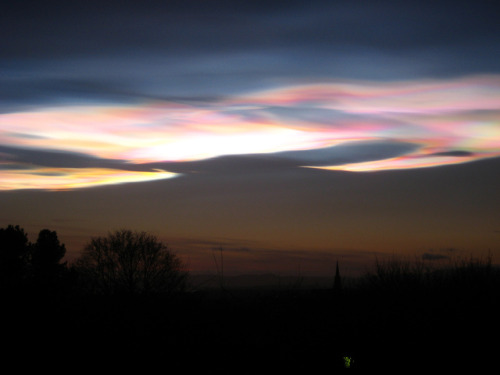


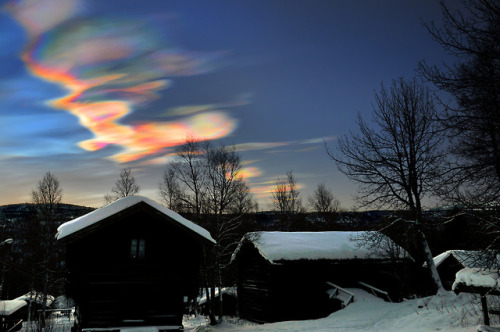
Polar stratospheric clouds or PSCs, also known as nacreous clouds, are clouds in the winter polar stratosphere at altitudes of 15,000–25,000 meters (49,000–82,000 ft). They are best observed during civil twilight when the sun is between 1 and 6 degrees below the horizon as well as in winter and in more northerly latitudes. They are implicated in the formation of ozone holes. The effects on ozone depletion arise because they support chemical reactions that produce active chlorine which catalyzes ozone destruction, and also because they remove gaseous nitric acid, perturbing nitrogen and chlorine cycles in a way which increases ozone destruction.
source / images: x, x, x, x, x, x, x, x
sure i guess sex is okay but have you ever closed a dozen tabs after finishing an academic paper

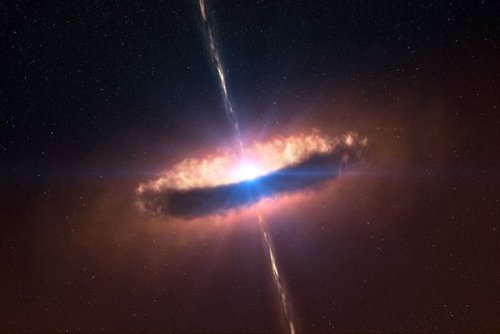



What is a protostar?
The formation of stars begins with the collapse and fragmentation of molecular clouds into very dense clumps. These clumps initially contain ~0.01 solar masses of material, but increase in mass as surrounding material is accumulated through accretion. The temperature of the material also increases while the area over which it is spread decreases as gravitational contraction continues, forming a more stellar-like object in the process. During this time, and up until hydrogen burning begins and it joins the main sequence, the object is known as a protostar.
This stage of stellar evolution may last for between 100,000 and 10 million years depending on the size of the star being formed. If the final result is a protostar with more than 0.08 solar masses, it will go on to begin hydrogen burning and will join the main sequence as a normal star. For protostars with masses less than this, temperatures are not sufficient for hydrogen burning to begin and they become brown dwarf stars.
Protostars are enshrouded in gas and dust and are not detectable at visible wavelengths. To study this very early stage of stellar evolution, astronomers must use infrared or microwave wavelengths.
Protostars are also known as Young Stellar Objects (YSOs).
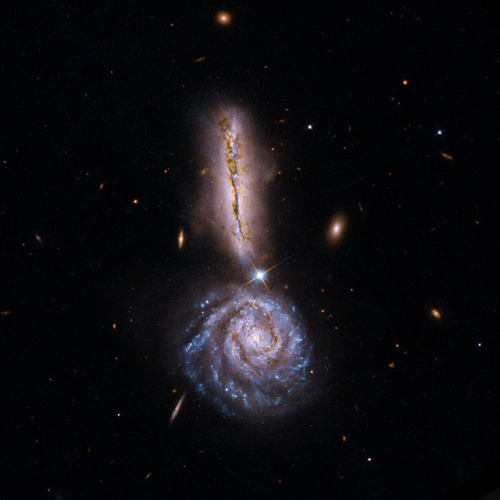
VV 340, pair of interacting galaxies in Boötes. The two galaxies shown here are in the early stage of an interaction that will eventually lead to them merging in millions of years.
Credit: NASA/STScI/NRAO/A.Evans et al


If you dropped a water balloon on a bed of nails, you’d expect it to burst spectacularly. And you’d be right – some of the time. Under the right conditions, though, you’d see what a high-speed camera caught in the animation above: a pancake-shaped bounce with nary a leak. Physically, this is a scaled-up version of what happens to a water droplet when it hits a superhydrophobic surface.
Water repellent superhydrophobic surfaces are covered in microscale roughness, much like a bed of tiny nails. When the balloon (or droplet) hits, it deforms into the gaps between posts. In the case of the water balloon, its rubbery exterior pulls back against that deformation. (For the droplet, the same effect is provided by surface tension.) That tension pulls the deformed parts of the balloon back up, causing the whole balloon to rebound off the nails in a pancake-like shape. For more, check out this video on the student balloon project or the original water droplet research. (Image credits: T. Hecksher et al., Y. Liu et al.; via The New York Times; submitted by Justin B.)

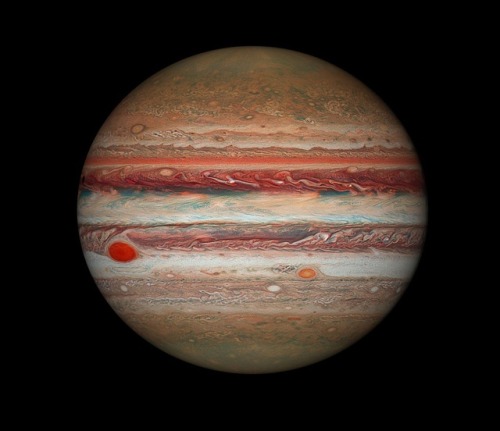
Hubble’s Jupiter and the Shrinking Great Red Spot
Image Credit: NASA, ESA, Hubble, OPAL Program, STScI; Processing: Karol Masztalerz
Once wounded, plants use calcium signals to warn distant tissues of future attacks.







Amazing views from the International Space Station (ISS)
-
 the-coventry-conundrum liked this · 5 years ago
the-coventry-conundrum liked this · 5 years ago -
 bbycraisin liked this · 5 years ago
bbycraisin liked this · 5 years ago -
 eors-archive reblogged this · 5 years ago
eors-archive reblogged this · 5 years ago -
 pltuo liked this · 5 years ago
pltuo liked this · 5 years ago -
 sgboom liked this · 5 years ago
sgboom liked this · 5 years ago -
 science1974 reblogged this · 6 years ago
science1974 reblogged this · 6 years ago -
 zygomorphous reblogged this · 6 years ago
zygomorphous reblogged this · 6 years ago -
 zygomorphous liked this · 6 years ago
zygomorphous liked this · 6 years ago -
 kilef reblogged this · 6 years ago
kilef reblogged this · 6 years ago -
 crlsgif reblogged this · 6 years ago
crlsgif reblogged this · 6 years ago -
 not-onlyedmlyrics liked this · 6 years ago
not-onlyedmlyrics liked this · 6 years ago -
 ricksiberian23 reblogged this · 6 years ago
ricksiberian23 reblogged this · 6 years ago -
 blzc-cb3 liked this · 6 years ago
blzc-cb3 liked this · 6 years ago -
 cactolith14-blog liked this · 6 years ago
cactolith14-blog liked this · 6 years ago -
 nekowaneteiru liked this · 6 years ago
nekowaneteiru liked this · 6 years ago -
 tattoos-and-fittedsuits liked this · 6 years ago
tattoos-and-fittedsuits liked this · 6 years ago -
 skullofjoy liked this · 6 years ago
skullofjoy liked this · 6 years ago -
 screwyoutunglr liked this · 6 years ago
screwyoutunglr liked this · 6 years ago -
 didyousaydragons liked this · 6 years ago
didyousaydragons liked this · 6 years ago -
 strangearbitersoul liked this · 6 years ago
strangearbitersoul liked this · 6 years ago -
 lencse liked this · 6 years ago
lencse liked this · 6 years ago -
 amtitkosvergodese liked this · 6 years ago
amtitkosvergodese liked this · 6 years ago -
 szonikuscsavarhuzo liked this · 6 years ago
szonikuscsavarhuzo liked this · 6 years ago -
 melbaroper liked this · 6 years ago
melbaroper liked this · 6 years ago -
 nuriakendo liked this · 6 years ago
nuriakendo liked this · 6 years ago -
 bumfuzzledreferences reblogged this · 6 years ago
bumfuzzledreferences reblogged this · 6 years ago -
 rtsnance reblogged this · 6 years ago
rtsnance reblogged this · 6 years ago -
 rtsnance liked this · 6 years ago
rtsnance liked this · 6 years ago -
 legally-adorable liked this · 6 years ago
legally-adorable liked this · 6 years ago -
 loudandclearnow reblogged this · 6 years ago
loudandclearnow reblogged this · 6 years ago -
 light--swagami reblogged this · 6 years ago
light--swagami reblogged this · 6 years ago -
 tumbleweed-chaser liked this · 6 years ago
tumbleweed-chaser liked this · 6 years ago -
 vital-moment liked this · 6 years ago
vital-moment liked this · 6 years ago -
 scatteredsplatteredspun liked this · 6 years ago
scatteredsplatteredspun liked this · 6 years ago -
 blaze-kitty liked this · 6 years ago
blaze-kitty liked this · 6 years ago -
 spaghetti--giraffe reblogged this · 6 years ago
spaghetti--giraffe reblogged this · 6 years ago -
 spaghetti--giraffe liked this · 6 years ago
spaghetti--giraffe liked this · 6 years ago